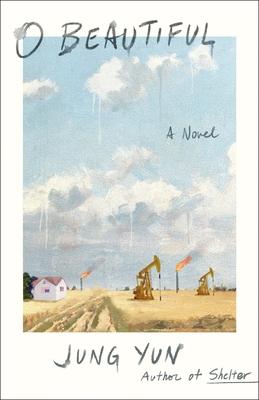O Beautiful is a story about America – a specific part of America, but it reflects attitudes and issues found nationwide. So it’s fitting that there’s a lot going on in this novel. Maybe a bit too much at times, but it definitely held my interest.
Elinor is a Korean-American in her early forties, previously a model, who went back to school and is now trying to carve out a career as a writer. After an affair with her professor, he volunteers her to write a story about the Bakken oil boom in North Dakota. Elinor grew up in the area, so she brings her own point of view to the story.
She’s meant to focus on the tensions between locals and outsiders (the “roughnecks” who come for oil jobs), but Elinor begins to see other stories, like tensions caused by the huge imbalance of men to women, and whether families have been cheated out of their land rights by corrupt oil corporations. And then there’s the woman who mysteriously went missing…
In this remote area of the country, Elinor experiences racism and sexism from many of the people she encounters. Even though she’s actually from the area, being Asian-American immediately marks her as “other” while the men also treat her as “exotic”. I enjoyed the play of insider versus outsider in this story, and how that same theme plays out in Elinor’s academic and family life as well. I especially liked Elinor’s troubled relationships with her sister, her father, and the mother who came to this country as a bride and then abandons her family. I also appreciated Elinor’s struggles with her own appearance, from capitalizing on her attractiveness as a petite, beautiful Asian woman, to marking her body with tattoos to end her career as a model, to now struggling to be viewed as competent based on her intellect. The title seems like a comment on both the United States (its physical beauty contrasted with its ugliness) and the way women (or all people) are objectified based on their appearance.
While I very much appreciated the complexity of the story, and enjoyed seeing this part of the world through Elinor’s perspective, it also felt like too many issues were raised and then discarded. As a journalist, Elinor seems a little like a dog chasing squirrels; she has a new story idea every day and her decision-making and work ethic leave a lot to be desired. Is her story about violence against women? Is it about hate crimes? Is it about corrupt land rights? Is it about children and women disappearing on reservation land? Is it about homelessness and the lack of economic opportunity for most blue-collar workers in the U.S.?
Most novels would tie all these disparate pieces together in some way. For example, the woman gone missing would be part of an evil corporate plot to bury a lawsuit for poisoning the water and giving all the locals cancer. I find books that connect every moving part unrealistic, so I appreciated that Yun didn’t go that route. I also appreciated that Elinor learns a lot over the course of this novel, about the people she’s interviewing, and about herself and how her own history is coloring her perceptions.
It’s a dark and often haunting book, from sexual assault and harassment to racism to environmental destruction. At the same time, Elinor meets genuinely interesting people, and where she’s expecting to see one conflict (locals versus “roughnecks”) the conflicts she encounters are much more complicated. It’s not easy to see which parties are the victims.
As a warning, I found the conclusion disappointing, but that’s often the case for me with a novel that raises so many complicated issues. I felt it fell off abruptly with little resolution. But then I also appreciate books that don’t end too neatly. I’d rather a book closes in a way that leaves me thinking about it, and this one did.
Note: I received a complimentary advanced review copy of this book from publisher St. Martin’s Press. This book published November 9, 2021.


